The best fights are not one-round knockouts. They’re the savage slugfests.
Rocky vs. Apollo Creed.
The new M2 vs. the new M4.
It’s not what BMW intended. But the match-up is inevitable.
Both of these super coupes are powered by the same basic superlative straight six (the V-8 is gone in lower-tier M BMWs thanks to Uncle and his fuel-efficiency mandates) and while the M4’s version of the 3.0 six is stronger, the M4 is also heavier – and so it accelerates only a bit more quickly. In fact, it’s close enough that a quicker M2 driver could absolutely get the drop on an M4 in a heads-up drag race.
And in the curves, both Ms are equally deadly weapons.
But, you do get a bigger car if you buy the M4, right? Certainly. On the outside. About 7 inches more car, end to end. But inside, these two offer about the same space.
Especially in the one category that’s probably the most relevant for buyers of two-door/four-seaters: backseat legroom. The M2 has 33 inches – the M4 33.7. That’s about three-quarters-of-an-inch of difference. And the M2 actually has more headroom back there.
Meanwhile, check the MSRPs.
You can own the new M2 coupe for $43,100.
The M4 coupe starts at $64,200.
That’s the one big difference between these two magnificent cars – and the one that may result in a TKO.
In favor of the M2.
The M235i is the amped-up version of BMW’s entry-level 2 Series coupe/convertible. It’s still technically a compact, but the 2 is significantly larger inside and out than the 1 Series coupe/convertible it replaces. And it’s awfully close, inside-wise, to the much more expensive (and nominally mid-sized) M4 coupe/convertible.
“M” in BMW lingo denotes a package of high-performance enhancements, including a larger – and much stronger – engine, an upgraded (and adaptive) sport-tuned suspension, faster steering, a more aggressive wheel/tire package, high-capacity brakes, a tuned exhaust system and exterior/interior trim enhancements.
Base price is $43,100 for a rear-wheel-drive M235i coupe with six-speed manual transmission. Opting for BMW’s xDrive AWD system – and the mandatory eight-speed automatic that’s paired with it – bumps the MSRP to $44,900.
The M convertible is automatic-only – and is also sold in rear-wheel-drive form only. Prices for the soft-top M2 haven’t been released yet (as of mid-November 2014) but will likely be in the range of $49k.
Official pricing – and the car itself – should be available by early spring 2015.
WHAT’S NEW
2015 is the first year for the M version of BMW’s 2 Series.
Some of the M’s high-performance chassis enhancements (but not the M-specific engine) and cosmetic details are now available as a la carte as options in the regular 228i coupe/convertible.
A gunfighter – with the finesse of a knife fighter.
Nearly as much room inside as in the M4.
About $21,000 left in your bank account vs. the M4.
Electronic nannies can be easily (and completely) turned off.
WHAT’S NOT SO GOOD
No satellite radio (or GPS) included … for $43k to start?
Spill-inducing cupholders.
Locking rear differential is extra cost.
BMW has been moving away from V-8s in its M cars – and horrible as this is in principle (government bureaucrats dictating what’s under the hood of the car you’re paying for) BMW end-runs Uncle on your behalf by slipping a six with the power of a V-8 under the hood of the M2.
Instead of the 228i’s turbo 2.0 four, you’ll find a turbo 3.0 straight six – BMW’s signature engine, as distinctive in layout as well as characteristics as Porsche’s flat six.
In the M2, it makes 320 hp (80 hp more than the 228i’s turbo four) and almost-V-8 torque (330 ft.-lbs.).
The default standard transmission is BMW’s eight-speed automatic with launch control and multiple automatic modes (Sport, Sport +, Eco and Comfort) as well as driver-selectable manual gearchange mode. A conventional six-speed manual transmission is a no-cost option… if you stick with rear-wheel-drive. The optional xDrive all-wheel-drive system requires the automatic. If you want the drop-top, you can have the six-speed manual or the automatic, but not all-wheel-drive.
It’s offered only with the coupe – probably because the added weight of both AWD and the extra bracing necessary in a convertible would crimp the car’s performance beyond acceptable parameters. 
Regardless of configuration, the M2 is an extremely speedy car. Low-mid fours, 0-60. Which qualifies this (ahem!) “entry-level” M for membership in a very elite club. In fact, the M2 is only slightly less speedy than the much more exclusive (in terms of its MSRP) M4, which has a 426 hp version of the BMW straight six – but which is also tasked with pulling several hundred pounds more car. It’s quicker than the M2 – but not hugely so. About three maybe four tenths of a second.
How quick are your reflexes?
Just as impressive as the M2’s power/performance is its economy.
At least, potentially.
If you can keep your foot out of it – which is like asking a healthy 18-year-old to keep it in his pants at the Bunny Ranch – the rear-drive M2 with the eight-speed automatic is capable of 21 city, 32 highway. Those would have been respectable numbers for an economy car with half the power and none of the fun just a handful of years ago. And for some additional perspective, consider that the previous 3 Series M coupe, which was V-8 powered, rated 14 city and 20 highway.
Interestingly, the manual transmission-equipped M2’s mileage is noticeably the poorer: 19 city, 28 highway. The automatic’s got a leg up at the pump because of its more tightly grouped gear spread – which keeps the RPMs lower when the six isn’t being called on to fire for effect. It also has an Eco mode that lets the very smart computer optimize the shift points to wring out as much mileage as possible.
This car has multiple personalities, both of them appealing.
It can be fierce – and friendly. As you like. This is perhaps the greatest virtue of modern high-performance cars. They are not temperamental. They can be driven – comfortably – in the worst stop-and-go gridlock.
But when the gridlock clears, it’s like like Clark Kent ripping away his tie and shirt, losing the glasses.. .
Even in gridlock, where the instant-on thrust of that lethally effective sweet six lets the M’s driver exploit brief windows of opportunity that are closed to other drivers in lesser cars. Stab the gas – and it’s as though you’ve already passed.
Though turbo’d, BMW has gone to some lengths to downplay the fact. There’s no whistle, no snapping sound of wastegates opening and closing. Not even a boost gauge. Instead, a seemingly bottomless wellspring of torque – the straight six’s 330 ft.-lbs. equivalent to the output of a non-turbo’d V-8 in the 4-5 liter range (Chrysler’s current 5.7 liter Hemi V-8 only makes 394 ft-lbs.). The twist is accessible immediately, peaking under 2,000 RPM and holding steady as the revs climb. This abundant torque on the low end (and mid-range) is key to the M’s friendly demeanor in the bump and grind of gridlocked traffic. It can laze along, hardly working to keep up.
But high horsepower awaits whenever the need – whenever the urge – arises. Ask and ye shall receive. Ever light a firecracker with a really short fuse? Be ready. Especially if you’ve turned the traction/stability control off. This car will leave rubber all over the road (more on that in a moment).
And this is an engine that always sounds good, too – unlike the regular 2’s turbo four. Which is a fine engine – just not a melodic one. This one is a Stradivarius of internal combustion.
A word on gearboxes:
Usually a manual is the enthusiasts’ choice in a car of this type. It is usually my first choice, at any rate. But the M’s eight-speed automatic is so responsive – and so configurable – that it in no way diminishes the automotive erotica of being at one with this car. For one thing – and it’s a big thing – BMW has programmed the ECU so that you can easily turn the e-Nannies all the way off and let ‘er rip with just as much ferocity as if you had a third pedal. Holeshots? You got ’em. Fifty yards of smoldering twin black stripes on the asphalt? Yours. The transmission has four modes, each one noticeably more or less aggressive, launch control – as well as full manual control, including chirp-the-tires upshifts that happen as fast and as furiously as a series of gut-punches from Sugar Ray Leonard in his prime. Those who read my columns will know I am a manual guy.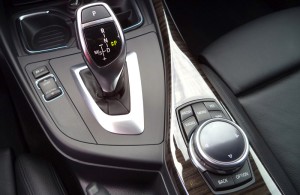
But I love this automatic. It enhances rather than waters down the experience. Trust me. Try it. You’ll like it, too.
The IKEA-ish drive-by-wire gear shifter is my only gripe. Oh, it’s faultless from a functional point-of-view. But it’s also soul-less. Like a game-boy toggle. Tap and touch. Very little in the way of tactile feedback. This car deserves something more engaging and communicative. In this respect only, the manual six-speed is emotionally superior. Just bear in mind that the car isn’t any quicker and accepting that you’ll have to give up a few MPGs along the way.
So, which would I choose?
Honestly, it’s a toss up. Even in the corners. The automatic grabs the right gear at exactly the right moment, in perfect syncopation with the engine (and your right foot). You miss out on nothing except, perhaps, the ego boost of timing a just-right shift yourself. But the automatic gets it right every time – and few of us (even the pros) can claim that honor. This also frees you up to concentrate on getting the most out of the engine, the suspension, the tires… 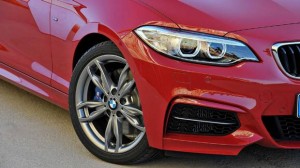
Short of being on two wheels, few cars react more immediately – more exactly – to the driver’s wishes than a BMW M. The steering is like a laser sight on a Glock. Point – and shoot. You are there. Bullseye, every time. And the chassis makes sure you get there. The M2 rides on a shorter wheelbase than the M4 (105.9 inches vs. 110.6) and – being several hundred pounds lighter – feels lighter. It “cuts” sharper – turning circle is 35.8 feet vs. 37.1 for the M4 – though you should be aware that the shorter wheelbase layout is easier to skitter if you’re really hauling the hay (and have the e-Nanny off). But going sideways through a curve is its own special treat. Just don’t forget to keep your right foot down – and cant the steering wheel in the direction you’d like to go. Then, hold on. The M will see you through – and you’ll feel 20 years younger at the end of it, I promise.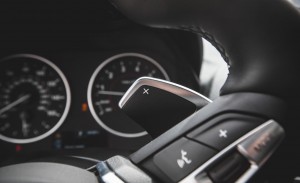
An interesting thing you’ll notice – with either transmission – is how very little rolling resistance this car has. Ease off the gas and – unless you’re on an uphill stretch – the car will coast along at the same speed for quite a distance before the speedometer begins to register any decline in velocity. Many brains sweated great buckets to figure out ways to cheat the wind, to negate friction. Which is, no doubt, part of the reason why this 320 hp rocket has about the same appetite for fuel (if you’re gentle with the pedal) as a current four-cylinder powered Toyota Camry.
For real.
It’s a bigger car, for openers.
About 2.5 inches longer overall than the now-retired 1 Series coupe – and exactly 1 inch wider. There is a great deal more interior space as a result – especially headroom for the driver and front seat passenger (40.1 inches now vs. 37.9 in the 1) though the back seat is still tight (33 inches, up from 32 in the 1), which ought to surprise no one familiar with the second row accommodations in compact sport coupes. It goes with the territory.
What is surprising is just how close the M2’s interior specs are to those of its bigger (on the outside) brother, the M4 – especially backseat-wise.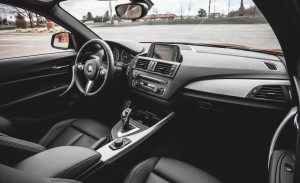
The M4’s got 33.7 inches of backseat legroom (a meagre seven tenths of an inch more than the M2’s got) and less backseat headroom (36.1 inches vs. 36.5 for the M2). There’s slightly more up-front legroom in the M4 (42.2 inches) but the M2’s 41.5 inches is very close – and very generous. A 6ft 3 inch man (me) still has several inches of air between his knees and the dashpad’s lower section without sliding the seat back as far as it will go. The M4’s additional .7 inches of legroom is thus superfluous unless you’re really tall – as in NBA tall – and then you might have an issue with the lesser headroom in the M4 (39.8 inches vs. 40.1 in the M2).
The take-home point is the M4’s larger overall size isn’t functionally meaningful – unless you just prefer the looks of a longer/bigger-on-the-outside car.
Styling-wise, the M2 is a less adorned car than the M4. It doesn’t have the Nike-style swoosh fender vents and side scalloping the 4’s got, for instance. Both cars are lookers to my eye. Not an ugly angle or awkward proportion anywhere. Either is a hot date – will it be the blond?
Or the brunette?
Also, the interior layouts are very similar – including the quality of the materials and attention to detail. It’s a place of business, executive boardroom style.
The only complaint I’ll register is directed at the typically German (and so, typically awful) cupholders, which in this case are too shallow – and too narrow – and located awkwardly ahead of the gear shifter in such a way as to almost guarantee spillage. I suspect this is deliberately done, because German designers think eating and drinking should be done in restaurants, not cars.
THE REST
All 2s – Ms and otherwise – are fitted with an automatic engine stop (and re-start) system, which is there to help squeeze out a fraction of an MPG here, a fraction of an MPG there – by cutting the engine when the car is stopped at red lights and so on. The system can be manually turned off – which will keep the engine turned on. But the driver must remember to do this each time he gets in the car. It’s a small annoyance – for which you can (once again) thank Uncle. The entire car industry (not just BMW) is scraping the bottom of the proverbial barrel to comply with the fuel economy fatwas emanating out of Washington.
You will probably not notice a difference. But if it improves BMW’s “fleet average” MPG numbers – however slightly – it will help BMW to continue building cars like this. And so, it’s a small annoyance worth putting up with.
The M package includes a body kit (subtle, unlike some M cars of the past), brushed aluminum trim plates, a thicker “M” steering wheel, specially bolstered sport buckets, LED accent lighting and a discreet rear spoiler – in addition to the mechanical/functional enhancements already described.
The thing that’s “entry level” about the M2 is that the car does not come standard with either satellite radio or GPS. Both are extra-cost options, bundled with the Technology Package. This upgrades you from the standard 6.5 inch dashtop mounted LCD display to a larger 8.8 inch display, along with an enhanced version of BMW’s mouse-input iDrive controller and a secondary touchpad for text entry. Though BMW gives you a lot of performance for the money, the fact that you have to pay extra for such accessories in a car with a base price of $43k is fairly cheeky given that satellite radio and GPS are very common features (and often standard equipment) in cars priced under $30k.
Also, the limited slip rear differential is optional. In a car this powerful, a limited slip diff ought to be standard. It’s arguably as necessary as a steering wheel. Be sure to buy this option … if you’d like those “summer” tires to last more than one summer.
THE BOTTOM LINE
How close is too close?
Is less than half a second worth another $21,000 (the cost of the jump to the M4 from the M2)?
I think either the M4 should be a lot quicker. Or cost a lot less.
Because the M2 really is that good.
If you value independent media, please support independent media. We depend on you to keep the wheels turning!
Our donate button is here.
If you prefer to avoid PayPal, our mailing address is:
EPautos
721 Hummingbird Lane SE
Copper Hill, VA 24079
PS: EPautos stickers are free to those who sign up for a $5 monthly recurring donation to support EPautos, or for a one-time donation of $10 or more. (Please be sure to tell us you want a sticker – and also, provide an address for us to mail the thing to!)


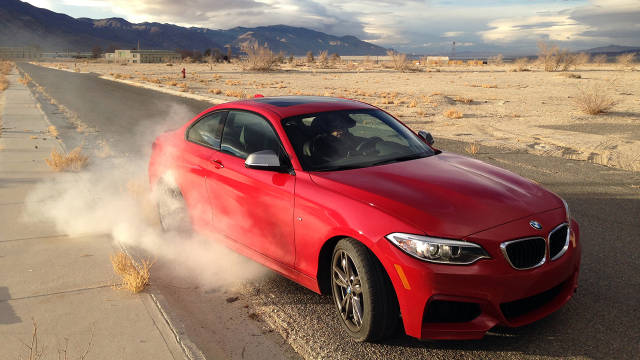

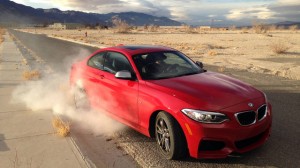
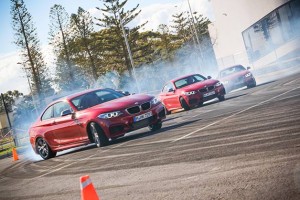

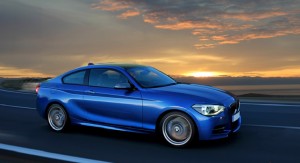

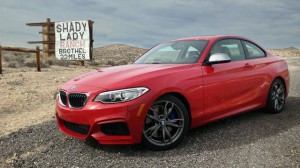






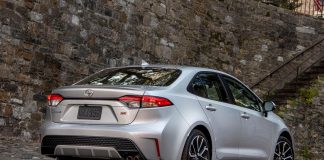
Ah, wimpy engine. Now here is an engine.
Biggest Cargo Ship on Earth launched
94,791 hp MAN B&W engine.
http://i.kinja-img.com/gawker-media/image/upload/s–cP9WNVt7–/c_fit,fl_progressive,q_80,w_636/18kzmo37frpj4jpg.jpg
As a kid, I was fascinated by huge steam reciprocating engines (e.g., as in Titanic). Monstrous – wonderful!
But, on the BMW: 320 easy hp (much more available) out of 3.0 liters is very impressive. My ’76 Trans-Am has a 7.4 liter V-8 that make about the same hp – with lots of sturm und drang. Choppy idle, etc. About 80 hp more is probably the limit before you’d get to “weekend bracket racer/not suitable for street driving.” But the BMW six (in the M4) is still hardly sweating at the 426 hp mark….
@Eric – Just a suggestion,- but maybe you could (article) describe how the automakers have been able to do that magic horsepower boost that older engines can’t.
Hi Gary,
Yup!
It’s basically a question of airflow.
My old Pontiac’s V-8 is limited by the capacity of the heads and valvetrain to facilitate the flow of air. A modern (and much smaller displacement) V-8 such as the current GM LS series flows something like twice the air due to vastly more efficient cylinder head design. These engines also use roller-type cams (allow more radical profiles than flat tappet cams without the associated “lumpy” characteristics).
Also – and I must concede this – port fuel injection is a huge factor. Fuel atomization is much superior. Big cams in the older stuff often had weak vacuum at idle/lower engine speed, which contributed to poor driveability, because the carbs had trouble atomizing the fuel. FI (and the roller-type cams) greatly improved this.
Of course, an engine such as the BMW six also has overhead (direct-acting) cams, four-valve heads, as well as variable cam/valve timing (airflow, again).
But real miracles have been worked with overhead/pushrod, two-valve engines – such as the GM LS V-8s.
Maybe when 3D printing goes mainstream with metals or ???? someone will produce retrofit kits for your Firebird.
I ordered a M235 loaded with everything including the BMW performance steering wheel. The same day they got in a S65 V8 M3 stripper with zero options thus quite lighter than a fully loaded M3 which I has before. After changing the seats and some “off road” exhaust options, a tune and underdrive pulleys my M3 is “pure”. It’s able to keep up with my 2014 M6 manual. Eric, to be precise this isn’t a M2 but a M235. BMW is planning a “Real” M2 in about 6 months. As BMW has moved to the less potent turbo six I may go for the Mustang GT-350. A 5.0L V8 pushing over 500HP N/A. BMW did this under the guise of saving fuel. The reality is the did it to no longer produce a “M’ only engine. I lament the loss of manufactures catering to their customers rather than government DICKtates.
BMW M has been heading towards a trim-level, rather than a driver’s performance option, for years. Probably the best M ever was the M3 Lightweight.
I wouldn’t sweat the lack of a standard GPS or satellite radio because, as you mentioned in an earlier article, those things go out of date fast, and you can’t easily upgrade. Far better to use your smartphone or tablet for that.
This will probably be my next car in a few years, after depreciation takes 40 to 60% off of the entry fee. I did the same with my current car, a 335i. Bought it for 41% of the window sticker price last year and it’s still an amazingly enjoyable creampuff of a ride. Just got the wife’s “new” used car: a G37 coupe, for 40-some % of sticker.
We will never buy new. We have almost $100K worth of cars in the garage for a little over $40K in cost.
Ditto that, Randy!
I have trouble understanding why anyone buys new… but I’m glad they do!
“All 2s – Ms and otherwise – are fitted with an automatic engine stop (and re-start) system, which is there to help squeeze out a fraction of an MPG here, a fraction of an MPG there – by cutting the engine when the car is stopped at red lights and so on … You will probably not notice a difference.”
Actually, it makes a huge difference. My V6 Avalon gets around 34 MPG cruising on the highway. It gets about 10 MPG in stop and go driving, in large part because of stop lights. If I’m driving through a city and time the lights just right, I’ll get 25 MPGs or so, but every time I stop the average fuel economy indicator for the tankful of gas slides down, because 0.0 MPG is a killer.
Hi Jim,
If one spends a lot of time “idling” in stopped traffic, one might see a noticeable gain. However, this should be viewed in context of the possibility of increased wear and tear on the engine, higher (and more frequent) replacement costs for the starter motor, the unpleasantness of the frequently quite perceptible stop-start cycling, the slight delay in reaction when accelerating (those of us who accelerate quickly and immediately) as well as the additional cost of the hardware and so on fitted to the vehicle.
To be clear: I don’t object to the technology per se. What I object to is that it is being effectively force-fed to us, because of government (rather than market) pressure.
“All 2s – Ms and otherwise – are fitted with an automatic engine stop (and re-start) system, which is there to help squeeze out a fraction of an MPG here, a fraction of an MPG there – by cutting the engine when the car is stopped at red lights and so on … You will probably not notice a difference.”
Actually, it makes a huge difference. My V6 Avalon gets around 34 MPG cruising on the highway. It gets about 10 MPG in stop and go driving, in large part because of stop lights. If I’m driving through a city and time the lights just right, I’ll get 25 MPGs or so, but every time I stop the average fuel economy indicator for the tankful of gas slides down, because 0.0 MPG is a killer.
Hi Jim,
You posted twice – but I’m only gonna reply once!
My bad. FN server squirrels. =P
“What I object to is that it is being effectively force-fed to us, because of government (rather than market) pressure.”
What I find interesting with the ongoing debacle of airbags that become anti-personnel weapons under some conditions is that no-one is taking the government goons to task for mandating that cars be equipped with these dangerous explosive devices in the first place. (To add insult to injury, air bags offer little or no additional protection to a properly-belted driver. They were conceived as a means to “protect” those who don’t wear seat belts.)
As far as I am concerned, it is the federal government that is at fault for those people who have been maimed or killed by air bags. (Of course dealing out pain, suffering, and death is all in a day’s work for the State.)
Hey Eric,
As an anarchist, I entirely agree with you that the federal government, even under that profoundly statist document called the Constitution that replaced the Articles of Confederation, has no business telling car manufactured what kind of cars to manufacture, how much fuel economy they must obtain, or what kind of cars consumers can purchase.
There may be a legitimate market niche for start-stop technology. The fuel savings, for some people, may be worth the balkiness you describe. In time we’ll know whether the increase in maintenance costs is greater or less than the fuel savings. But, fuck the CAFE standards foisting that loss of choice upon unwilling customers like you who doubt its effectiveness or worth. Let markets, not sociopathic con men and women who claim to be our rulers, decide that question.
This thing’s side profile is too feminine in my opinion.
They are clovers, a common theme here. I don’t understand the origin of the term as it applies to annoying drivers though.
The Urban dictionary has a good definition for clover. Although, I am still curious of the terms origin.
BMW needs to rationalize their product line. This looks like one they should keep, as it sounds like this car gets back to their roots – light weight, high performance, driver oriented.
While the price is double what one would have paid in the days of the 2002 — $2500 in 1968 is $24k these days, you get a lot more for the money — like not being crushed to death in a car crash, for one. As well as mid-four’s 0-60 – something that only drag-strip cars could do back then.
The new M2 sounds like a great combo of automotive virtues.
The way you describe it, this car will possibly cannibalize BMW’s own product line, luring buyers away from the M4. And that is usually a BAD IDEA for any automaker.
Before I can agree or not, will have to compare the visual appeal of these two. If the M4 looks significantly more “upmarket,” it’s intended buyers may willingly pony up the extra $. If not………
It’s a fabulous car – and you know that’s raise praise, coming from me!